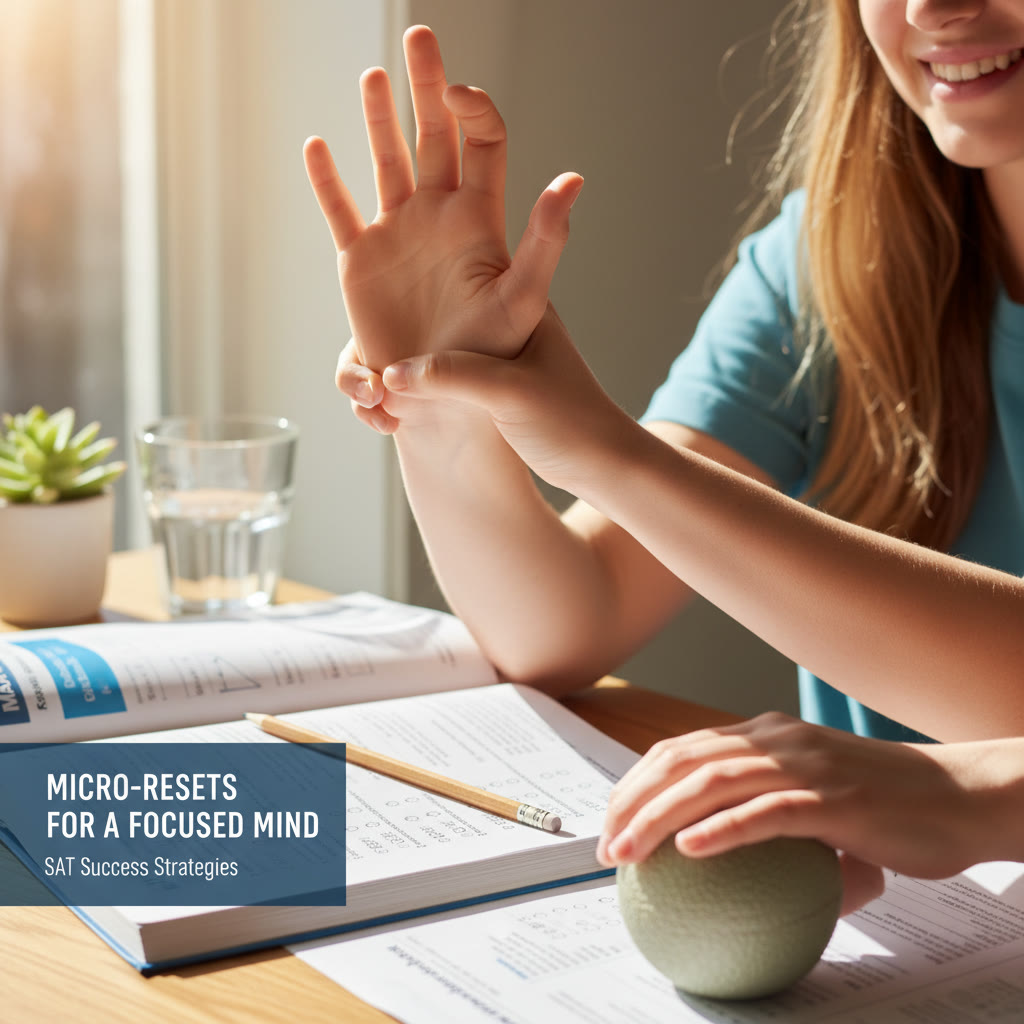Why Mental Stamina Matters on the SAT
Picture this: you’re halfway through the SAT reading section. Your eyes are skimming faster than your brain can absorb. Questions that looked straightforward in practice now feel fuzzier. That collapse in clarity and confidence isn’t because you’re not smart—it’s because your mental stamina is being stretched thin. The SAT doesn’t just test knowledge; it tests sustained attention, working memory, and decision-making under pressure.
The SAT is roughly a three-hour sprint of concentration (with short breaks), and that’s a long time for any brain to stay at peak performance. Building mental stamina means learning to keep your cognitive engine running smoothly from the first section through the last question. It’s the difference between a good practice score and an excellent test-day performance.
What mental stamina actually is
Mental stamina is the brain’s ability to sustain focus, resist distractions, recover from mistakes, and perform consistently over an extended period. Think of it like cardiovascular fitness, but for attention and reasoning: you train it, you rest it, and over time it gets stronger.
How the Brain Tells You It’s Getting Tired
Recognizing early signs of fatigue helps you react before mistakes compound. Common signals include:
- Slower reading speed or re-reading the same sentence
- Jumping to answers without fully processing the question
- Physical signs like tight shoulders, a headache, or shallow breathing
- Emotional responses—irritability, anxiety, or an urge to rush
When these show up during practice, treat them as data—not failure. They tell you what to change in your routine.
Practical Practices to Build Stamina (Weekly Plan)
Building stamina requires a mix of long-term habits and targeted training. Below is a sample weekly plan that balances intensity, recovery, and variety. Adapt durations to your schedule—consistency is more important than perfect timing.
| Day | Focus | Session Type | Duration | Goal |
|---|---|---|---|---|
| Monday | Timed Section Practice | High Intensity | 60–90 minutes | Simulate section timing and pacing |
| Tuesday | Short Active Review | Low Intensity | 30–45 minutes | Target weak question types and error analysis |
| Wednesday | Endurance Practice (Back-to-Back) | Moderate–High | 2–3 hours | Build sustained focus across multiple sections |
| Thursday | Skills Drills | Low–Moderate | 45–60 minutes | Targeted grammar, math concepts, vocabulary in context |
| Friday | Mindfulness & Recovery | Low Intensity | 30–40 minutes | Active recovery: breathing, stretch, light review |
| Saturday | Full Practice Test | High Intensity | 3–4 hours | Simulate test day and review timing, pacing |
| Sunday | Reflection & Light Study | Low Intensity | 30–60 minutes | Plan next week, mental reset |
This roadmap trains both the ability to sprint (tight timing practice) and to run a marathon (full tests and recovery). The big-picture goal: your brain learns to recover quickly between high-demand bursts and to stay steady during extended work.
Daily Habits That Multiply Your Stamina
Small habits compound. The difference between a tired brain and a sharp one often comes down to how you treat your body and mind between study sessions.
Sleep like you mean it
Sleep is non-negotiable. Deep sleep consolidates memory and preserves executive function. Aim for 8–9 hours on practice-heavy days and prioritize consistent bed and wake times. If you’re cramming late the night before a big practice, you’ll trade immediate hours for long-term performance—and that rarely pays off.
Fuel for cognition
Your brain runs best on steady glucose and good hydration. Meal and snack ideas that support sustained focus:
- Breakfast: oatmeal with nuts and fruit or a Greek yogurt parfait
- Snack: banana with peanut butter or a small handful of almonds
- Lunch: lean protein, whole grains, and vegetables (avoid heavy greasy foods)
- Hydration: water throughout the day; avoid sugary drinks during study blocks
On test day, eat the breakfast that you practiced with—new foods can cause unpredictable reactions.
Micro-movement and posture
Tight shoulders and shallow breathing drain energy. After 25–30 minutes of seated study, stand, stretch, take a 2–5 minute walk, or do light jumping jacks. These small breaks refresh circulation and improve oxygen flow to your brain.
Train Like an Athlete: Progressive Overload for Focus
Progressive overload isn’t just for muscles. Gradually increasing cognitive load helps your attention hold up under pressure. Start with manageable timed blocks—say 30 minutes of focused work—and add 5–10 minutes each week. You’ll push your brain without shocking it.
Examples of progressive practice
- Week 1: Two 30-minute focused sessions with 10-minute breaks.
- Week 2: Two 40-minute sessions with 10-minute breaks.
- Week 3: One full section under timed conditions; review errors afterwards.
Balance the increase in practice time with rest and reflection. If you push too hard, your performance will drop; if you push slowly, your stamina grows sustainably.
Targeted Practice: How to Simulate Test-Day Fatigue
It’s one thing to do a tired practice and another to simulate the exact conditions of test day. Here are ways to mimic the real thing so your brain knows how to behave when it matters most.
- Work in a quiet, unfamiliar space once a week. Test centers aren’t your bedroom—practice where the surroundings are different.
- Use full-length, timed sections back-to-back to create cognitive fatigue.
- Practice with physical constraints: sit in a straight-backed chair, use only allowed materials, and wear the clothes you’ll likely wear on test day.
- Control snacks and timing: eat the same breakfast, use the same break routine, and practice how you’ll use the break time for refueling and resetting.
Techniques to Manage Mental Fatigue During the Test
When fatigue hits, you want a toolkit of quick, reliable resets. These techniques take less than a minute and can take you from foggy to functional.
Three quick resets
- Box breathing: inhale for 4, hold for 4, exhale for 4, hold for 4. Repeat twice.
- Grounding with details: name five things you can see, four things you can touch, three you can hear. It’s surprisingly calming.
- Micro-stretch: roll your shoulders, tilt your head, and take three deep diaphragmatic breaths.
Use these during a test break or quietly at your desk—0.5 to 2 minutes can reset your attention and reduce impulsive errors.
Error Analysis: Turn Failures into Fuel
Every wrong answer is an opportunity to strengthen mental stamina if you analyze it correctly. Focus not just on what you got wrong, but on why you got it wrong when you were tired.
Questions to ask during review
- Was the mistake due to content knowledge or rushing? (e.g., did I neglect a key step in algebra or misread a word?)
- Did my performance change over time? (e.g., do I start strong but drop after the second passage?)
- What strategy will prevent this next time? (slower reread, marking, or skipping and returning)
Log these patterns in a short practice diary. Over weeks, you’ll see reliable trends that tell you where to invest practice time.
Study Environment and Tools That Support Endurance
Your environment is the stage on which stamina plays out. Small changes can make long study sessions feel easier.
- Lighting: bright, indirect light reduces eye strain.
- Noise: use noise-cancelling headphones or low-volume instrumental playlists if background noise is distracting.
- Timer: use a visible timer for sections; it prevents the drain of constantly checking a watch.
- Materials: have scratch paper, pencils, and a bottle of water within reach to minimize interruptions.
Mindset Work: Resilience and Micro-Goals
Stamina isn’t only physical. Mental narratives—what you tell yourself during the test—shape how long you can stay focused.
Use micro-goals to stay present
Breaking the test into tiny, trackable goals keeps your mind anchored. For example, tell yourself: “I’ll focus fully for this single passage” or “I will mark and move through five problems right now.” That micro-commitment reduces overwhelm and creates a series of small wins that energize you.
Normalize imperfections
Mistakes will happen. Instead of catastrophizing an error, practice a quick mental reset: note the mistake, decide “fix it later if time,” and continue. This prevents a single slip-up from consuming your attention.
When to Get Extra Help: Strategic Support
If you find progress stalls—if fatigue predicts worse scores rather than improvements—it may be time for targeted support. Personalized tutoring can make a big difference because it tailors strategies to how you actually get tired, not just what you get wrong on paper.
Sparkl’s personalized tutoring, for example, blends 1-on-1 guidance with tailored study plans and expert tutors who identify both content gaps and endurance leaks. Their approach often includes AI-driven insights to track patterns in attention and errors, helping students practice smarter and recover faster. When used naturally—alongside your own disciplined practice—this kind of support accelerates stamina-building by focusing on your unique weaknesses and optimizing the way you spend study time.
Sample Daily Checklist for Test-Week
Use this checklist in the week before your test to conserve mental energy and ensure readiness.
- Night before: 8–9 hours sleep, lay out test materials, plan breakfast
- Morning of: balanced breakfast, short walk, 5–10 minute breathing routine
- During test: use micro-breaks, box breathing, and planned snack/water during the permitted break
- After practice tests: 30–45 minutes of light review and 1 hour of rest
Real-World Examples: What Works For Students
Here are short, anonymized vignettes to show how different strategies help different students.
Emma: The Slow Burner
Emma starts strong in every practice but loses speed halfway through the Math section. She found success by adding endurance sessions once a week: two back-to-back math sections under timed conditions. She paired this with nightly sleep hygiene—no screens an hour before bed—and improved both accuracy and sustained speed.
Jamal: The Distracted Multitasker
Jamal studied in noisy environments and thought multitasking helped him feel productive. When he switched to a structured Pomodoro schedule (25 minutes on, 5 off), removed his phone, and practiced full-length tests in quiet spaces, his concentration improved dramatically. Micro-goals helped him stay present and reduced impulsive guessing.
Sofia: The Nervous Perfectionist
Sofia’s main issue was that a wrong answer would derail her for several questions. Her tutor introduced a reset routine: a quick breathe, mark-and-move policy, and a short physical reset during breaks. This approach reduced catastrophic spirals and stabilized her score across sections.
Measuring Progress: What to Track and Why
Quantify stamina gains, but measure the right things. Don’t just track scores—track how you perform across time and under fatigue.
- Section consistency: compare accuracy in the first half vs. second half of each section
- Error type frequency: are careless mistakes decreasing?
- Recovery speed: how long to return to baseline after a break or mistake?
- Subjective energy: a weekly 1–10 scale for how alert you felt during practice
These metrics tell a more complete story than raw test scores alone.
Putting It All Together: A One-Week Simulation
To show how the pieces fit, here’s a one-week focus plan that compresses the principles above into a single cycle before a practice test.
- Day 1: Baseline full-length practice test. Note fatigue points and error trends.
- Day 2: Targeted review of errors (45–60 minutes), plus active recovery.
- Day 3: Two timed sections back-to-back; simulate break routine.
- Day 4: Light skills work (grammar drills, math facts), 30–45 minutes.
- Day 5: Mindfulness, sleep focus, and a short practice to keep skills fresh.
- Day 6: Full-length practice under test conditions.
- Day 7: Review test, update study plan, and rest.
Each week you repeat this cycle, tweak the load, and increase the intensity slightly. If you feel stuck, consider targeted sessions with a tutor to address persistent patterns—Sparkl’s 1-on-1 guidance and tailored study plans are designed to do exactly that, focusing on where your stamina breaks down and how to repair it efficiently.
Final Notes: Consistency, Not Burnout
Building mental stamina for the SAT is a marathon of good habits, not a sudden sprint of late-night cramming. The most effective students mix disciplined practice with rest, structure with flexibility, and physical care with mental strategies. Be compassionate with yourself: progress is often incremental and sometimes uneven.
When you treat your brain like an athlete—training it with progressive overload, fuelling it properly, and giving it recovery—you’ll not only perform better on test day, you’ll also gain study skills that serve you well beyond the SAT.


Ready to Build Stamina?
Start small: pick one new habit to add this week—consistent sleep, a breathing routine, or one endurance session—and track how it changes your focus. If you want a guided approach that adapts to your specific patterns, personalized tutoring can accelerate results. Sparkl’s combination of expert tutors, tailored study plans, and AI-driven insights can help pinpoint where your stamina wanes and design practice that fixes the real problem, not just the symptoms.
Above all, trust the process. With thoughtful, consistent training, your mental stamina will grow—and with it, your confidence on test day.


















No Comments
Leave a comment Cancel